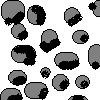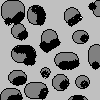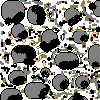Soil structure
The soil structure (also: soil structure ) is a term used in soil science and describes the spatial arrangement of solid soil components. The total soil volume of the soil matrix is divided into the volume of the solid soil substance and the pore volume .
This division has a significant impact on the soil and air balance, the rooting capacity , the availability of nutrients and similar soil and plant physiological properties. In general, the coarser the structure of a soil and / or the more densely packed the individual structural unit is, the less favorable its soil properties are.
Structure forms
The following structural forms are macroscopically well addressable according to the cohesion of the soil particles as well as the degree of cementing or secretion:
-
Basic structure , neither through biological nor physical processes, a structure has emerged.
- Single grain structure (also "elementary structure") - in sand and gravel, in freshly deposited silt and in silt and mud flats, the primary particles are not cohesive;
- Coherent structure - clay / silt / loam sediments: are held together by cohesive forces and form an undivided mass;
- Putty structure - the primary particles are glued or cemented to one another by substances displaced in the soil. A putty only at the points of contact of the grains appears microscopically as a so-called "shell structure".
-
Aggregate structure - the primary particles (grains) are combined to soil aggregates (structural bodies) through physical or biological processes
-
Structure in which the soil particles u. a. Merge them into heterogeneous structures using soil biological processes:
- Crumb structure - agglomeration of soil particles that are loosely stored or can be stuck together (then also referred to as "sponge structure") - example: humus top soil of a garden soil;
- Wurm solution structure - from earthworms excreted, bonded by excreted in the earthworm gut materials, a few millimeters large soil aggregates;
-
Separation structure (also known as “segregation structure”) - caused by shrinkage processes with repeated drying and re-humidification from a basic structure through separation. The structures of the segregate structures are further differentiated according to size and shape:
- Crack structure - predominantly vertical shrinkage cracks;
- Layer structure - predominantly horizontally aligned structures, horizontal axis> vertical axis;
- Pillar structure - rounded at the top, vertical axis> horizontal axis;
- Prismatic structure - sharp-edged, coarse structures, vertical axis> horizontal axis;
- Polyhedron structure - sharp-edged, multi-faceted, intermeshing structures with mostly smooth surfaces; Vertical axis and horizontal axis approximately the same; Diameter coarse polyhedron> 10 mm; Fine polyhedron diameter 1 - 10 mm;
- Sub-polyhedron structure - similar to polyder structure, but with more rounded edges; multifaceted, little intermeshing structural bodies with predominantly rough surfaces;
- Plate structure - horizontal axis> vertical axis; as a result of pressing and thus signs of soil compaction , e.g. B. under lanes or plow soles , but also by the pressing effect of ground ice ;
- Wedge structure (also "parallelepipedge structure") - due to strong swelling and shrinking in soils with high contents of swellable clay minerals , e.g. B. Vertisols , resulting wedge-shaped structural bodies
-
Structure in which the soil particles u. a. Merge them into heterogeneous structures using soil biological processes:
Crack, layer and column structures are also grouped into macro-coarse structures, prism, polyhedron, sub-polyhedron, plate and crumb structures to form macro-fine structures.
-
Fragment structure - created through soil cultivation or anthropogenic relocation. They are divided into:
- Crumbling structure - irregularly shaped structural bodies, diameter <5 cm;
- Lump structure - irregularly shaped structures, diameter> 5 cm, originated e.g. B. by plowing when the condition is too wet;
- Rolling units - spherical structural bodies that z. B. caused by transport on conveyor belts; recently the term has also been used generally for naturally formed, round soil aggregates.
There are also microstructure shapes that are determined in thin sections under the microscope .
Note
The definition of the term soil structure is similar to that of the geological term of the rock structure . Strictly speaking, the term soil structure only describes the aggregate and fragment structure; the basic structure is characterized by the lack of a bottom structure.
literature
- Ad-hoc Working Group Soil: Soil Science Mapping Instructions , Ed .: Federal Institute for Geosciences and Raw Materials in cooperation with the State Geological Services, 5th edition, 438 p .; 41 figs., 103 tabs., 31 lists, Hannover 2005. ISBN 978-3-510-95920-4
- Karl Heinrich Hartge : Introduction to Soil Physics , p. 33, Stuttgart 1978 ISBN 3-432-89681-6
- D. Schroeder : Soil Science in Key Words , Unterägeri 1984, pp. 58–60, ISBN 3-266-00192-3
- W. Amelung, H.-P. Blume , H. Fleige, R. Horn, E. Kandeler , I. Kögel-Knabner , R. Kretschmar, K. Stahr , B.-M. Wilke: Scheffer / Schachtschabel textbook of soil science. 17th edition. Heidelberg 2018. ISBN 978-3-662-55870-6 .
Web links
- Videos on soil structure published by the Institute for Scientific Film . Provided in the AV portal of the technical information library .
- Soil structures on the HyperSoil website of the University of Münster
Individual evidence
- ↑ Ad-hoc-AG Soil: Soil Science Mapping Instructions , 5th edition Hannover 2005, p. 117-120 .
- ^ Food and Agriculture Organization of the United Nations (FAO) : Guidelines for Soil Description, 4th ed. Rome 2006, ISBN 92-5105521-1 (English).
- ↑ Ad-hoc-AG Soil: Soil Science Mapping Instructions , 5th edition Hannover 2005, p. 119 .
- ↑ W. Amelung, H.-P. Flower u. a .: Scheffer / Schachtschabel textbook of soil science. 17th edition Heidelberg 2018, p. 251 .



